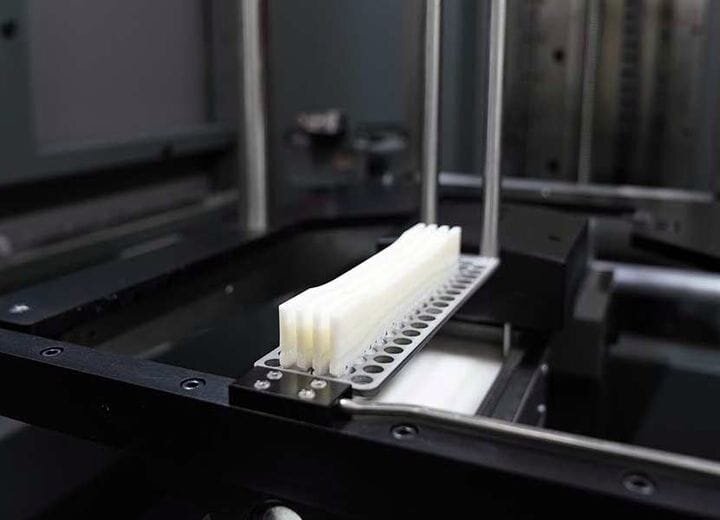![Testing experimental 3D printing resins with RPS’ materials development kit [Source: RPS]](https://fabbaloo.com/wp-content/uploads/2020/05/image-asset_img_5eb08d04a3092.jpg)
RPS produces a reliable SLA 3D printer, the NEO 800. But they offer an optional “Materials Development Kit” for it.
SLA machines use liquid photopolymer resin, which is selectively solidified by a powerful laser that sweeps across the resin, layer-by-layer. Use of any SLA machine, including RPS’ NEO 800, requires this material as the major consumable, which forms the main cost component of any prints.
DSM Somos and RPS
RPS is not a chemical company producing resins; they make 3D printers, and good ones, too. Like many SLA 3D printer manufacturers, they’ve instead partnered with a third party expert to provide materials for their equipment. In their case they’ve made arrangements with DSM Somos.
RPS currently lists 14 different DSM Somos resins for use in their equipment, including:
-
Somos Taurus
-
Somos Element
-
Somos EvoLVe 128
-
Somos PerFORM
-
Somos PerFORM Reflect
-
Somos WaterShed XC 11122
-
Somos NeXt
-
Somos WaterClear Ultra 10122
-
Somos GP Plus 14122
-
Somos ProtoTherm
-
Somos Protogen Series
-
Somos 9000 Series
-
Somos NeXt LV Grey
-
Somos BioClear
Each of these materials offers different properties, and it’s a simple matter to select the one that best meets your application requirements.
But what if it doesn’t? What if RPS does not offer a material of the desired nature?
Experimental 3D Printing Resins
It turns out this is a more frequent occurrence than one might imagine. RPS has customers that prefer to experiment with different materials, or even develop entirely new ones.
I wouldn’t say this is straightforward, but it can be as simple as mixing in different additives to the resin to add coloration, composite materials and other effects. I suspect some proportion of owners of other SLA 3D printers also perform such development.
Large Format 3D Printer Resins
If you are suitably technically inclined and able to perform such development, great. But wait, there’s a problem. A big problem.
The RPS NEO 800 is a rather large device, having a build volume of 800 x 800 x 600 mm. This means that to operate the machine, you must top it off with some 630L of photopolymer resin.
That could be very expensive to do, as photopolymer resin is not actually the least expensive liquid on the product shelf. And it’s an even worse situation if you were one of the resin experimenters: imagine mixing up 630L of experimental resin only to find it didn’t work and you have to try again.
With another 630L of expensive resin!
You get the idea. Experimenting with resin on a large volume SLA 3D printer is financially challenging.
RPS Materials Development Kit
Enter the RPS Materials Development Kit. This is a hardware series that can dramatically simplify the expense of developing custom resins on the NEO 800. Here’s how it works.
A small resin tank of dimensions 45 x 165 x 40 mm is placed within the normally huge NEO 800’s build chamber. This small tank accepts only a single liter of resin, and can be used to perform initial experiments on a prototype resin. Aspects like curing time and laser strength can be worked out easily, without the need to dump hundreds of wasted liters of resin.
Then, RPS offers a larger development tank of dimensions 230 x 165 x 150 mm, which accepts up to thirteen liters of resin. This smaller volume can then be used to 3D print parts of reasonable size to effect another level of resin testing.
This is a truly brilliant idea that can allow manufacturers to more cheaply develop custom resins to gain an advantage over their competitors, while using the same 3D printer they would for production purposes.
If your organization is tempted by the notion of custom resins, you may wish to review the RPS solutions.
Via RPS

